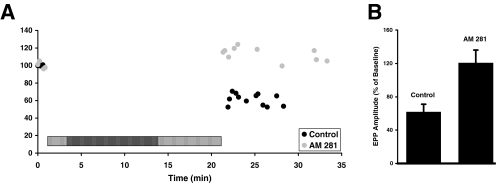Fig. 10.
Synaptic depression requires functional CB1 receptors. (A) Time course of end-plate potential (EPP) amplitudes from two representative experiments in which the motor nerve was stimulated for 20 min at 1 Hz (indicated by the horizontal hatched bar). The experiment was performed either under control conditions (black) or in the presence of N-(piperidin-1-yl)-5-(4-iodophenyl)-1-(2,4-dichlorophenyl)-4-methyl-1H-pyrazole-3-carboxamide (AM 281) (grey). Each data point represents the amplitude of an average of eight sweeps. (B) Mean percent reduction of EPP amplitudes (from initial baseline readings) following 20 min of continuous 1-Hz stimulation of the motor nerve. Stimulation was delivered either under control conditions (n = 11) or in the presence of AM 281 (1 µm; n = 7). The mean EPP amplitudes under these two conditions are significantly different from each other (P < 0.05; Student's t-test). Baseline measurements were either made under control conditions or in the presence of AM 281, as appropriate for the experiment. Error bars represent SEM.

